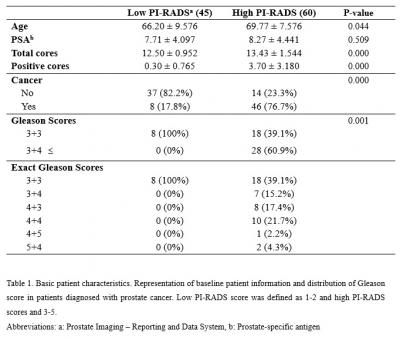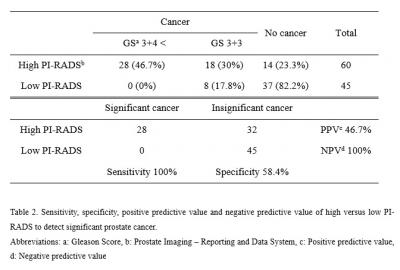|
Cancer - Prostate(구연)
|
(E-115)
|
|
|
Prostate biopsy is unnecessary in low Prostate Imaging - Reporting and Data System (PI-RADS) score lesions |
Department of Urology, Kyung Hee University School of Medicine
Department of Radiology, Kyung Hee University School of Medicine¹ |
| Dong Soo Kim, Dong-Gi Lee, Gyeuong Eun Min, Seung Hyun Jeon, Hyung-Lae Lee, Sun-Ju Lee, Choong Hyun Lee, Sung-Goo Chang, Sung Kyoung Moon, Joo Won Lim, Sang Hyub Lee |
Purpose
We evaluated whether the Prostate Imaging - Reporting and Data System (PI-RADS) could reduce unnecessary prostate biopsies.
Materials and Methods
Patients with prostate-specific antigen (PSA) levels ≤ 20 ng/ml who underwent prostate magnetic resonance imaging (MRI) for evaluation from January 2018 to November 2019 were analyzed. Among them, 105 patients who received transrectal ultrasonography (TRUS)-guided biopsy were included. PSA, PI-RADS scores, biopsy results and Gleason scores (GS) were evaluated. Biopsies with GS higher than 3+4 were considered significant and biopsies with no cancer or Gleason 3+3 were considered insignificant.
Results
Among the 105 patients, 45 patients had low PI-RADS and 60 showed high PI-RADS scores. There were no patients with significant prostate cancer in the low PI-RADS groups. For the high PI-RADS group, 28 (46.7%) had significant cancer and 32 (53.3%) had insignificant cancer. The sensitivity and specificity of high PI-RADS to detect significant cancer was 100% and 58.4%. Positive predictive value was 46.7% and negative predictive value 100%.
Conclusions
Low PI-RADS scores on MRI did not show significant prostate cancer and surveillance should be considered in selected cases to prevent unnecessary invasive procedures and overdiagnosis.
|
  |
|
keywords : Prostate cancer, Magnetic resonance imaging, Biopsy |
|

